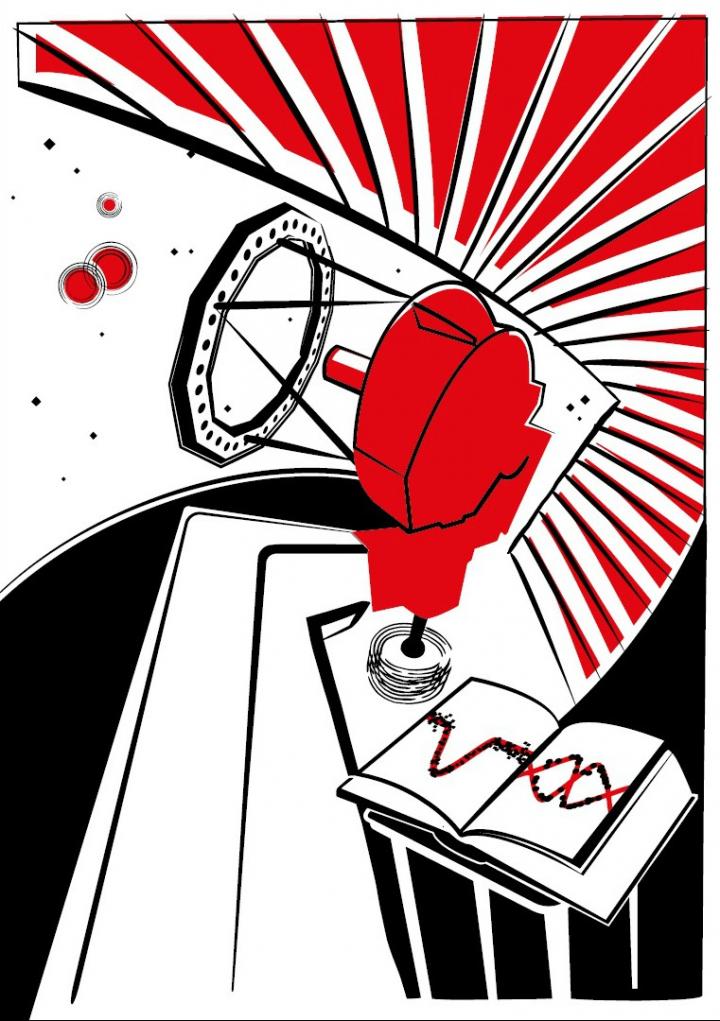
Credit: University of Birmingham / Amanda J. Smith.
Astronomers working on ‘first light’ results from a newly commissioned telescope in Chile made a chance discovery that led to the identification of a rare eclipsing binary brown dwarf system.
The discovery, published today in Nature Astronomy, was led by an international team of researchers, including scientists at the University of Birmingham, working on the SPECULOOS (Search for habitable Planets EClipsing ULtra-cOOl Stars) project. SPECULOOS involves the University of Birmingham in collaboration with the University of Liège, the University of Cambridge, the University of Bern, the Institute of Astrophysics of the Canaries, the Massachusetts Institute of Technology, and other partner institutions.
SPECULOOS’ mission is to investigate planets surrounding ultra-cool dwarfs, a category that includes the smallest stars that exist, as well as objects called ‘brown dwarfs’. Brown dwarfs are ‘sub-stellar’ objects, meaning they have less mass than a star but more than a planet. Brown dwarfs are unable to sustain the fusion of hydrogen into helium, a process that powers the light from normal stars like the Sun.
Astronomers predict that these ultra-cool dwarfs should host large populations of close-by, potentially habitable rocky planets, offering a wealth of opportunity to explore a diversity of atmospheres and climates. An example is the 7-planet system TRAPPIST-1, which was discovered by members of the same team.
Soon after the construction the first SPECULOOS telescopes, and during testing observations, the team targeted the known brown dwarf 2MASSW J1510478-281817, since renamed 2M1510, in the constellation Libra. The SPECULOOS observations picked up a distinct signal that led the researchers to speculate that 2M1510 might be two brown dwarfs instead of one, in orbit around each other.
Dr Michaël Gillon, Principal Investigator of the SPECULOOS project, said: “Among the first test observations we performed, we turned one of our telescopes to a known brown dwarf. But suddenly the object appeared to get dimmer for about 90 minutes, which indicated an eclipse just took place.”
Artem Burdanov, a postdoctoral researcher at MIT added: “We rapidly realised that we were probably looking at two eclipsing brown dwarfs, one passing in front of the other, a configuration which is much rarer than planetary systems.”
The researchers were able to confirm their hypothesis using two more powerful telescopes, the 10m Keck Telescope in Hawaii, and the 8m Very Large Telescope in Chile. The VLT is based at the same site as the SPECULOOS telescopes used to make the observations. Keck and VLT have sensitive spectrometers that can be used to measure the velocities of celestial objects. In the case of 2M1510, the astronomers detected the velocities of both brown dwarfs as they orbit one another.
“From the very first spectrum we obtained, we could tell we had an exciting binary discovery,” says Adam Burgasser, professor of Physics at the University of California, San Diego, who led the spectroscopic analysis. “It was thrilling to see the absorption lines move back and forth in perfect synchronicity, and this allowed us to measure the mass of the binary.”
The detection of eclipsing brown dwarfs is extremely rare – only one other such system has been identified to date. These systems provide astronomers the opportunity to measure the brown dwarfs’ radii and masses directly, which are fundamental quantities for theoretical models. 2M1510 is also special in that it is among the very few brown dwarfs that has a known age, due to its membership in a nearby cluster of young stars called the Argus moving group.
“Collecting a combination of mass, radius and age is really rare for a star, let alone a brown dwarf,” said Dr Amaury Triaud, from the School of Physics & Astronomy of the University of Birmingham, who was the lead author of the study. “Usually one or more of these measurements is missing. By drawing all these elements together, we were able to verify theoretical models for how brown dwarfs cool, models which are over 30 years old. We found the models match remarkably well with the observations, a testament to human ingenuity.”
###
The data that made this discovery possible were obtained by the SPECULOOS-South observatory, one of the facilities participating in the SPECULOOS project. SPECULOOS-South is hosted by the European Southern Observatory at its Paranal Observatory in Chile. SPECULOOS-South is funded by the European Research Council (ERC), as well as the Simons Foundation, the MERAC foundation, and the Science, Technology and Facilities Council. The SPECULOOS project also involves telescopes in Tenerife (Spain), and in San Pedro Martir (Mexico).
The team the produced the discovery consists of researchers from the University of Birmingham, the University of California, San Diego, the University of Liège, the Institute of Astrophysics of the Canaries, the American Museum of Natural History, the University of Cambridge, the University of Bern, the Massachusetts Institute of Technology, the University of Göttingen and the University of Warwick.
Notes to editor:
- The University of Birmingham is ranked amongst the world’s top 100 institutions. Its work brings people from across the world to Birmingham, including researchers, teachers and more than 6,500 international students from over 150 countries.
- Triaud et al (2020). ‘An Eclipsing Substellar Binary in a Young Triple System discovered by SPECULOOS. Nature Astronomy.
- Additional information about the research can be found at http://www.
trappist. and http://www.one speculoos. uliege. be - The Illustration’s copyright is University of Birmingham / Amanda J. Smith.
It is an artist view of one of the SPECULOOS telescopes, with the eclipsing binary brown dwarf in the sky. The third red dot, is a third nearby brown dwarf, which is also part of the same system. The book on the side shows the data that led to the discovery. On the left page is the eclipse captured by SPECULOOS while the right page shows the data from Keck and the VLT.
Media Contact
R Lockwood
[email protected]




